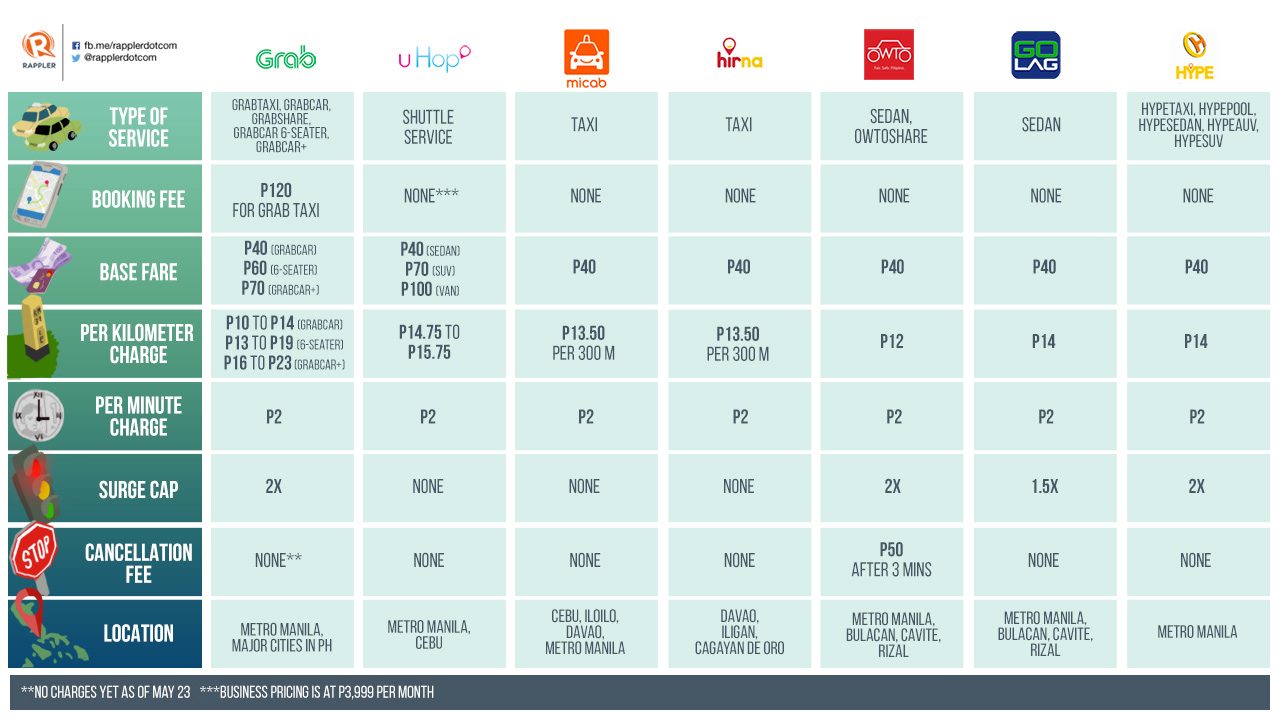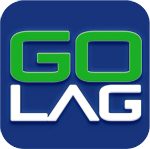SUMMARY
This is AI generated summarization, which may have errors. For context, always refer to the full article.

MANILA, Philippines – Do you know the new ride-hailing apps?
With the exit of Uber from the Philippine ride-hailing market, many Filipino commuters were left with only Grab.
But in April, the Land Transportation Franchising and Regulatory Board (LTFRB) accredited 5 new ride-hailing companies that offer booking services for taxis, sedans, and other vehicle types.
So who are the new players and what can they offer? And more importantly, how much will they charge?

New ride-hailing apps
MiCab
 MiCab Systems Corporation is a taxi-hailing company which traces its roots to a startup ideation camp in Cebu City in 2012. It has been operating in the city since then.
MiCab Systems Corporation is a taxi-hailing company which traces its roots to a startup ideation camp in Cebu City in 2012. It has been operating in the city since then.
MiCab is a wordplay for Mobile Internet Cab, with the aim to modernize taxi operations. (WATCH: 6 questions with the founder of new Grab competitor, Micab)
With its accreditation, MiCab looks at venturing into the Metro Manila market while maintaining operations in Cebu, Iloilo, and Davao.
MiCab does not charge booking fees. Commuters only have to pay what is on the taxi meter. Under government-approved fares, taxis charge a P40 flagdown rate, with an additional P13.50 every 300 meters and P2 per minute travel.
The company supports its operations through MiAds or advertisements placed inside its taxis.
HirNa
 Like MiCab, HirNa Mobility Solutions Incorporated is another transport network company (TNC) that is focused on giving taxis a platform for bookings.
Like MiCab, HirNa Mobility Solutions Incorporated is another transport network company (TNC) that is focused on giving taxis a platform for bookings.
HirNa chief executive officer Coco Mauricio earlier said they saw the “need to tap into an existing transportation mode such as taxis.” The company started in Davao City in 2017 as part of the city’s transportation master plan.
HirNa is now looking at expanding to Metro Manila, Iligan City in Lanao del Norte, and Cagayan de Oro in Misamis Oriental.
The app has a 24/7 hotline service for bookings to cater to commuters who do not have smartphones. It also has a button within the app that directly connects to the hotline of the LTFRB, should there be problems with the ride.
To place bookings, patrons don’t have to put their destination, unlike other ride-hailing apps. They can choose between a taxi sedan or a taxi AUV.
HirNa doesn’t charge booking fees as well, with commuters paying only what is on the taxi meter.
The LTFRB recently allowed all ride-hailing firms to charge P2/min travel. This means that Hirna may start charging per-minute rates starting September 21, if they decide to do so.
Owto
 Owto is a TNC by Ipara Technologies and Solutions Incorporated, founded by former Grab and Uber drivers who wanted to make the ride-hailing industry a profitable one for drivers.
Owto is a TNC by Ipara Technologies and Solutions Incorporated, founded by former Grab and Uber drivers who wanted to make the ride-hailing industry a profitable one for drivers.
Paulo Libertad, Owto’s chief operating officer, said they charge the smallest commission among other companies at 15%. The average commission charged is at 20% of driver’s earnings, not including incentives.
Owto recently launched on May 18. Like Uber and Grab, it offers transport network vehicle services for sedans around Metro Manila, Bulacan, Rizal, and Cavite. It also has a pooling feature.
It charges a fee of P50 if cancellations are done 3 minutes after the booking was made.
Under its approved fares, Owto charges a base fare of P40, with an additional P12 per kilometer and P2 per minute travel. They set a surge cap of times two the fare for the distance traveled and duration of the ride.
Go Lag
 Go Laguna, or Go Lag for short, is a ride-hailing service looking at offering rides to Greater Metro Manila Area commuters, who are sometimes rejected by existing ride-hailing drivers because of the distance.
Go Laguna, or Go Lag for short, is a ride-hailing service looking at offering rides to Greater Metro Manila Area commuters, who are sometimes rejected by existing ride-hailing drivers because of the distance.
Originally intended to serve the province of Laguna, Go Lag expanded its intended market to Metro Manila, Cavite, Rizal, and Bulacan.
Go Lag has yet to launch its app, but is currently accepting driver applications.
It will be a ride-hailing platform for sedans. Go Lag will be charging a base fare of P40, on top of P14 per kilometer and P2 per minute travel. Surge pricing is capped at 1.5 times.
Hype

Among the TNCs, Hype Transport Systems focuses on the security of both drivers and commuters. Though the app is not yet available for download, Hype will feature an “SOS” button in times of emergencies.
Hype will offer different vehicle types for commuters ranging from taxis and sedans to AUVs and SUVs. It will also offer a ride-sharing service for sedans.
The flagdown rate for each service depends on the vehicle type. Sedans will have a base of P40. For SUVs, it’s at P70, and for vans, P100. There will be an additional charge of P14 per kilometer and P2 per minute, with a surge cap at times two the charge.
Meanwhile, Hype’s ride-sharing service has a P30 flagdown rate on top of P9.50 per kilometer travel.
Existing ride-hailing apps
Grab
 Grab, through MyTaxi.PH, has been in the Philippine market since 2013, offering taxi-hailing services. In 2015, it launched its private vehicle booking service as well as more luxurious cars.
Grab, through MyTaxi.PH, has been in the Philippine market since 2013, offering taxi-hailing services. In 2015, it launched its private vehicle booking service as well as more luxurious cars.
Grab is available in Metro Manila and major cities around the Philippines.
It recently got involved in a controversy involving its fares, when PBA Representative Jericho Nograles accused it of illegally charging its customers P2 per minute of travel on top of its government-approved pricing scheme. The charge was suspended in April. (READ: Did Grab ‘illegally’ charge its riders higher fare?)
LTFRB said that Grab can now charge P2 per minute since it allowed all firms to do so, but the order will not affect its pending case before the regulatory board.
In December 2016, the LTFRB regulated TNCs’ fares, allowing Grab to charge a flagdown rate of P40 for sedans, with an additional P10 to P14 per kilometer.
For a 6-seater vehicle, Grab charges a flagdown rate of P60, with P13 to P19 per kilometer. For premium cars, the base fare is at P70 on top of P16 to P23 per kilometer.
Grab launched a 100-day campaign geared toward improving driver and passenger experience. It is looking at imposing cancellation fees as well.
U-Hop
 U-Hop was granted a license to operate as a TNC by the LTFRB back in March 2016.
U-Hop was granted a license to operate as a TNC by the LTFRB back in March 2016.
Among TNCs, U-Hop is the only company that offers shuttle services to individuals and companies.
When it launched in July 2016, U-Hop only offered shuttle services with a capacity of 7 passengers. It now offers the same services as Uber and Grab, which is to pre-arrange taxi, private car, and social carpooling rides.
It is operational in Metro Manila, Cebu, and other major cities. But in February, U-Hop was suspended in Batangas, with the local government requiring documents necessary for operations.
U-Hop charges P40 for sedans, P70 for SUVs, and P100 for vans, with an additional P14.75 to P15.75 per kilometer and P2 per minute of travel. For companies, they charge a monthly membership of P3,999 for 40 prioritized rides. – Rappler.com
Add a comment
How does this make you feel?
There are no comments yet. Add your comment to start the conversation.